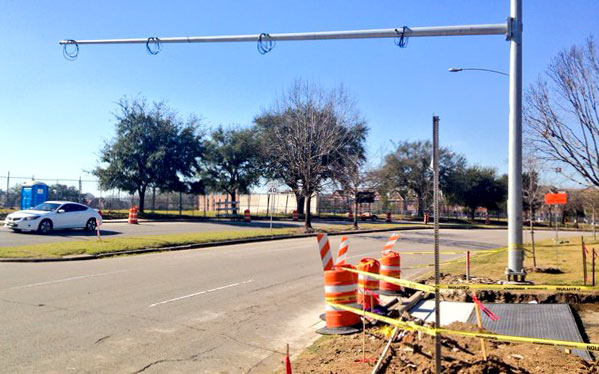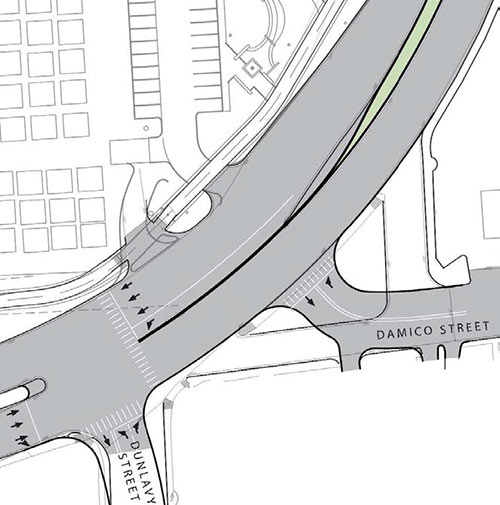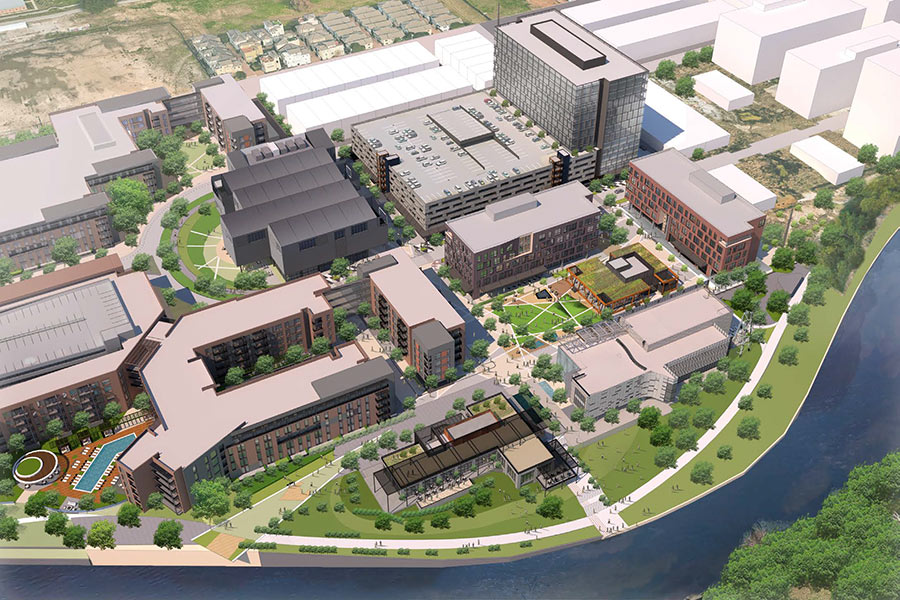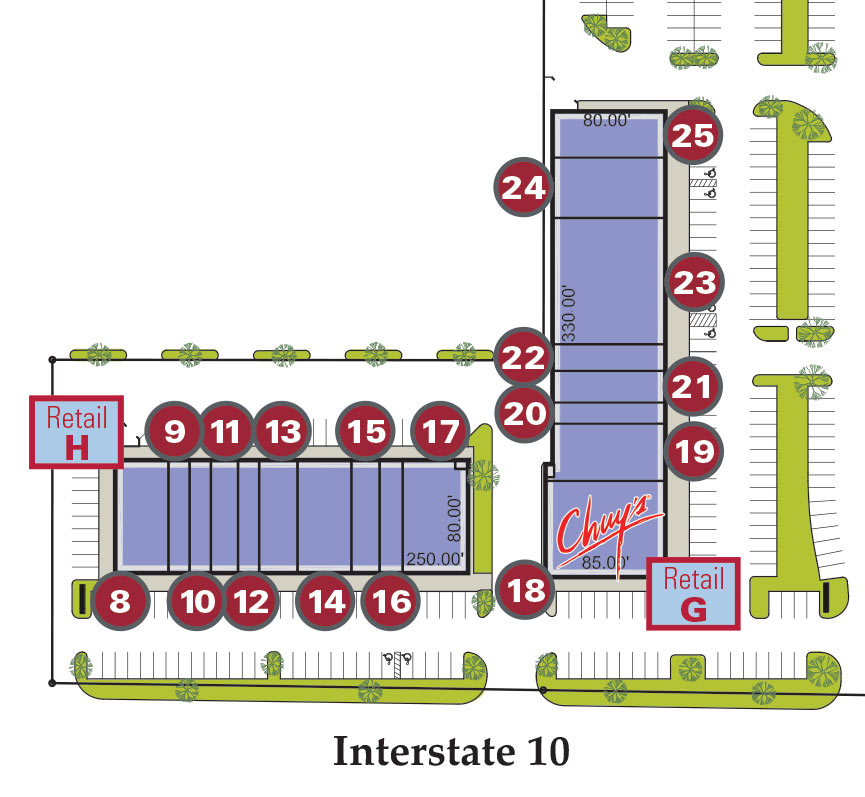
The metal arm of a future traffic signal is now reaching out of the ground across a few westbound lanes of Allen Pkwy. at the intersection with Dunlavy St. The new crosswalk will protect foot traffic on the way to bayou-side party-venue The Dunlavy and to the Adath Yeshurun Cemetery next door.
The stoplight fits into the larger plans to revamp Allen Pkwy., in part intending to dial down the road’s speeds from not-quite-freeway to next-to-a-park levels. The redo also aims to make it simpler for both cars and people trying to make their way to all the new park infrastructure and improvements along Buffalo Bayou.
A drawing from early last year shows the plan view of the finished intersection at Dunlavy:
***

Those plans for the westbound signal setup appears to include a dedicated left-turn-only lane, for those trying to high-tail it down Dunlavy back to central Montrose.
- Previously on Swamplot: Take These Preview Drives Down the New, Slower, and More Parkway-Like Allen Parkway, with 175 New Bayou-Side Parking Spaces
Images: Allyn West (photo), Downtown Redevelopment Authority (street plan)





Oh goody. More lights. MORE congestion.More stops. As if traffic isn’t already congested.
That’s where many drivers like to hit their top speed.
Any possibility of say putting a cop or two on Allen Parkway and issuing speeding tickets? Maybe the reason people drive like nuts in this town is that there are no repercussions for such behavior.
@Padraig – I’ve never met someone who is patently “anti-stop light.” Met lots of other “antis,” but this is a new one for me.
@Frank: they’re all too busy camping a captive audience and pulling people over for expired registration stickers on the Katy Tollway.
@Padraig: lights don’t create congestion; cars create congestion. Cyclists and pedestrians can now get across without needing to dash and pray for luck. And drivers that want to race along the bayou can use Memorial.
Use of the bayou has exploded with all the new amenities. The Dunlavy gets a lot of traffic for breakfast and lunch and has events in the evening. Also, one day before the end of time the lot across the street will be developed into something and put even more stress on that intersection. If you want to put the pedal to the metal, you have Memorial Drive. Allen Parkway needs to slow down.
Exactly what we need on a major east west thoroughfare more slowdowns. We should be eliminating lights and raising speed limits. Not the opposite.
They needed to do something to make this intersection safer for pedestrians. The parking lot at The Dunlavy fills up so quickly that many park visitors need to park south of Allen parkway and cross the street there.
That light is not too far from where Houston attorney John O’Quinn hit a tree and met his maker in 2009.
Memorial is the major east-west thoroughfare. Allen Parkway is, well, a Park Way. By definition and intent these are slower-paced roads.
Wasn’t O’Quinn driving like a maniac? At least his estate probably sued the tree and then named a forest the O’Quinn Forest.
Why not a pedestrian bridge over the road?
What is it about 40mph that makes people think it’s OK/safe to drive 55? They’re not routinely driving 50 in the 35s (most of them, anyway), so why do they suddenly get all speedy when the limit ticks up slightly?
Rant aside, that is a GREAT place for a traffic light. The road curves at that point, so there are terrible sight lines and many lanes to cross when turning from Dunlavy. You know, plus all the speeding.
@Cody: How about both? Also…
http://swamplot.com/imagining-a-people-friendly-allen-pkwy-crossing/2016-02-04/
@Houstonreader. “lights don’t create congestion; cars create congestion.” Tell me that again when you drive the mile on Westheimer/Elgin between Bagby and 59 or pretty much any major street going east-west through Midtown or Downtown
The best thing you can do for a neighborhood is to slow down the cars.
Cody,
That would be nice, too, but the other main reason for this light is to allow traffic to turn on to and off of Dunlavy more easily. A couple more pedestrian bridges along Allen Parkway would make sense eventually, though, especially if the empty lots at Montrose, Gilette, and Dunlavy ever get built up. But the lights with pedestrian crossings being added at the latter two are a good start.
pedestrian bridges = very expensive
granite boulders should be placed among the median (killer) trees
let speeding drivers eliminate themselves!
(I like driving fast on the Allen. Still alive.)
@JT Tell me about it. Once they put in the left turn arrow on North on Louisiana, the light timing went to shit. I used to be able to bet my life that the walk sign would turn when I reached the corner, not so any more. On Sunday I got stuck at ALL FOUR lights until I hit Main. 100 yards every 3 minutes drove me mad. I wish I knew who to call and complain to. It wouldn’t be so bad if it wasn’t perfect before they fiddled with it.
@JT: You’re confused. You have mixed up congestion (road clogged with cars) with lower speed (road with stop lights).
@houstonreader: I’m confused huh? 12-15 traffic lights in a mile span with 2/3rds not synchronized equals traffic piled up to near gridlock. But you said ” “lights don’t create congestion; cars create congestion.” If the lights do not work properly then cars pile up therefore creating congestion and lower speed.
@heyheyhouston. Supposedly calling 3-1-1 will help.
As a cyclist this is great news. . This intersection has been screaming out for a light or bridge for years.
@JT: You’re still confused. The effect of what you describe is to slow traffic down. The presence of a lot of cars is what creates congestion. I’ve driven that stretch you describe, both when there are lots of cars and when there aren’t, and it’s the number of cars around that make the biggest difference in how quickly I get through.
That said, your larger argument is based on an apples and oranges comparison. You take the worst-case scenario of multiple traffic lights, poorly-timed as an argument against the light at Dunlavy. I don’t think so.
Overhang from Mayor Parker’s crusade to slow down city traffic in Houston. Many major streets have had their speed limits reduced over the last 4 years. People living near Dunlavy that think it’s great to put in a traffic signal because traffic moves too fast, that’s the equivalent of moving into a house at the end of an airport runway and then complaining about aircraft noise. Allen Parkway has been there for 70+ years.
This is excellent news. Great news for drivers making a left turn going south on Dunlavy (will not be protected) and drivers will now be allowed to turn left on to Allen Pwky. The extra lights being added along Allen Pwky are expected to add one minute to drivers drivetime to downtown. And if Regent Square is ever built we’ll never be able to imagine this intersection without a stoplight.
Since those who severely worry about automobile congestion are heavily reliant on numbers generated from traffic analyses, why not refer to the traffic analysis that was produced for this project? http://www.mainstreettirz.com/images/150205_Allen_Parkway_Public_Meeting_Final.pdf
Slide 30 summarizes the difference in travel times prior to and after Allen Parkway improvements (including the added signals). Findings => travel times should increase by a whopping 59 SECONDS during peak hour. I think 59 seconds added to travel time is worth it if it means that we are heading in the direction of 0 pedestrian and bicyclist fatalities and increased access to our amazing BBP.
Sheesh – so much petty back-and-forth. As is usually the case, both sides are partially right. Traffic control devices can restrict efficiency and flow of traffic. But you need traffic control devices to ensure the general safety of the public, including those not inside automobiles.
Things change. Yes “Allen Parkway has been there for 70+ years.” But in that time: the population of the city has grown six-fold; the area around Buffalo Bayou went from (1) an urban forest to (2) a neglected and seldom used park to (3) the crown jewel of the Houston parks system with thousands of daily users; and interstate highways now bisect the city, connecting far-reaching corners of the region that were once rice fields and cattle pastures.
Anytime you debate public safety issues, it all comes down to a tug-of-war between efficiency and public safety. In the end, you have to compromise both. In theory, if you reduced the nation-wide speed limit to 5 mph, traffic fatalities would drop by say 99%. However, you will still have 1 or 2 freak accidents, and the national economy would grind to a halt. On the other hand, you could eliminate all red lights and raise the speed limit on Allen Parkway to 75 mph, and you would end up with so many fatalities and bad accidents that it would cause public outrage.
Now that the park space along Buffalo Bayou is being used much more frequently by many more people arriving via bicycle and on foot, Allen Parkway is due for some increased traffic control.